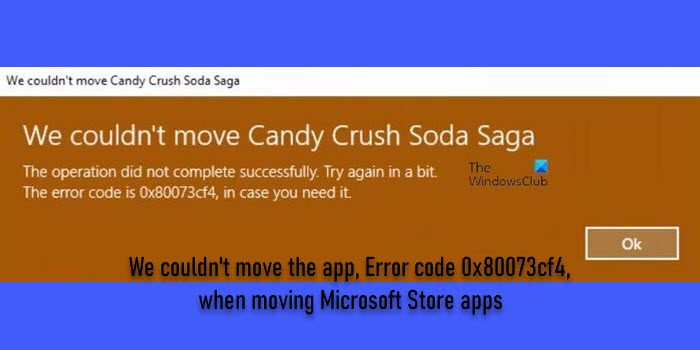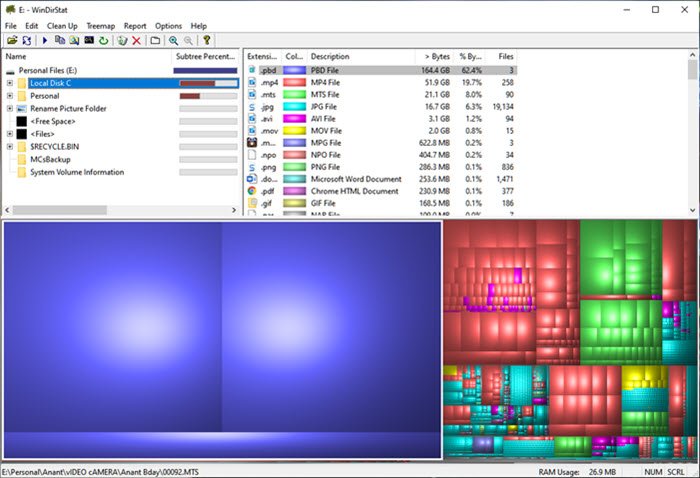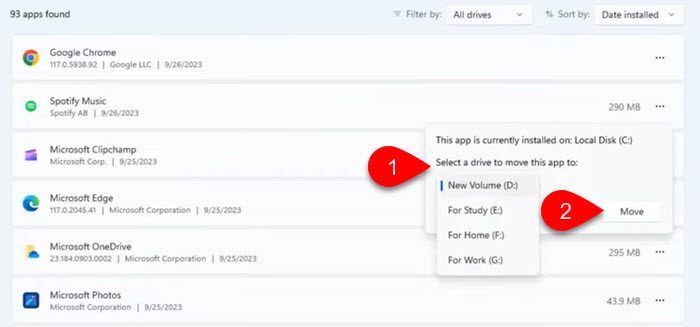Windows 11 and Windows 10 allow you to move apps to a different location if the developer allows it. However, at times, you may face an error where the transfer of the app from one portion to another fails, and one such error code is 0x80073cf4. It usually happens when moving large-size apps, and you will receive an error message that says:
We couldn’t move the app. The operation did not complete successfully. Try again in a bit. The error code is 0x80073cf4, in case you need it.

We couldn’t move the app, Error code 0x80073cf4
The error code points to a specific issue, which, according to Microsoft document, is:
ERROR_INSTALL_OUT_OF_DISK_SPACE
In simple words, there isn’t enough disk space on your computer. You will have to free up some space on the destination drive or portion, and then retry moving the app. Now that it is clear what needs to be done, follow these methods to clear space on your hard drive or use alternate methods.
- Create space on the destination partition or drive
- Find what is taking space on the drive
- Free up & increase hard disk space on Windows 11/10 computer
- Retry moving the app
- Move the app to another drive or partition
Before we move ahead, it is only applicable to apps and games you download from the Microsoft Store and not the usual EXE files.
1] Create space on the destination partition or drive

Find what is taking space on the drive
We have a list of free applications that can help you find what is taking up space on your hard drive in Windows 11/10. The interface of the software on the list is specially designed so you can figure out what is taking space. It can be the movie files or backup of your picture collection, and they are arranged so that figuring them out is not easy.
Usually, apps and games that take up a lot of space on your primary drive can be moved, so not only do apps not get slow as files become larger, but the primary partition where Windows is installed also has enough space to operate.
It is especially useful in the case of SSD, where the drive gets slower as storage gets low.
Free up & increase hard disk space on Windows 11/10 computer
Once you know the files that are taking up space, you can move them to a different place or external storage. Even uploading to an online storage solution is viable these days.
Make sure you have more than, at least twice, the storage space in the destination drive compared to the actual size of the application you want to move (go to Settings, navigate to Apps > Installed apps, locate the app you want to move and note down the size of the app).
To reclaim disk space on your Windows PC, run the Disk Cleanup Utility, uninstall programs, or run third-party junk cleaner software to remove unwanted files in a few clicks.
2] Move the app to another drive or partition

If you have more drives or partitions, try moving the problematic app to that drive or partition.
Select the app in the Apps > Installed apps section and click on the Move button. The button will reveal where the app is currently installed and let you choose the destination drive or partition. Once you select that, click on the Move button to start the process. The completion of the process will depend on the size of the application and will not get stuck because of storage issues.
I hope this is clear that the error occurs because of the shortage of storage space, and the only way out is to clear space on the destination folder, and then attempt to move it.
What is error code 0x80073CF0 on Windows Store?
Error code 0x80073CF0 might appear when you try to download, install, or update applications from the Microsoft Store. The error indicates problems with system files, corrupt app data, or issues related to the Microsoft Store cache. It can be caused due to interrupted updates or insufficient device storage. To fix the error, try running the Windows Store Apps Troubleshooter, resetting Windows Store components, or re-registering the Store app using PowerShell commands.
What is Windows Store error code 0x80073cfb?
Error 0x80073cfb on the Microsoft Store is a common error that can occur while installing or updating an app. It often indicates that there are conflicts with the app installation, such as corrupted installation files, insufficient permissions, interference from third-party security software, or issues with the Microsoft Store cache. To resolve the error, disable your security software temporarily to see if it’s causing the issue, run the built-in Store Apps Troubleshooter, or run the wsreset.exe command to clear the Store cache.
Read Next: Microsoft Store error codes, descriptions, resolution: Complete list.